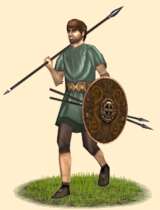Gaesamica (Javelineers)
 |
Weapons | Defence | Mental | ||||||
|---|---|---|---|---|---|---|---|---|---|
| Primary | Secondary | Armour: | 3 | Morale: | 9 | ||||
| Type: | spear | spear | Shield: | 2 | Discipline: | normal | |||
| Attack: | 5 | 13 | Skill: | 9 | Training: | untrained | |||
| Charge: | 2 | 2 | Recruitment | Other | |||||
| Lethality: | 1 | 0.125 | Soldiers: | 60 | Hit Points: | 1 | |||
| Range: | 57.8 | 0 | Cost: | 1035 | Mass: | 0.9 | |||
| Ammo: | 6 | 0 | Upkeep: | 259 | |||||
| Turns: | 1 | ||||||||

The Gaesamica constitute the largest number of Celtiberian warriors who fought as light spearmen. They’re fast, proficient at flanking manoeuvres and harassing the enemy line before joining the melee.
Expert at Hiding in Woods
Can Hide in Long Grass
The Gaesamica (Guy-sah-mek-ah; "Javelineers") constitute the majority of Celtiberian warriors who fought as light spearmen. They’re fast, being proficient at flanking manoeuvres and harassing the enemy line before joining the melee. Lightly equipped however with just a buckler and a leather cap, they shouldn’t be used as line infantry, being better suited for the flanks, supporting heavier troops.
Made up of the lower classes of warriors and freemen who own weapons, these men are generally only used to raiding the enemy’s outlying villages and herds, preferring to stay out of the more serious border disputes. These times however may bring with them a need for greater numbers of warriors to fight increasingly larger enemy armies.
Theirs is a simple battle-kit, made up of a leather cap, the Iberian caetra, a bundle of javelins and a decent spear that they use in a light infantry or medium skirmisher role.
Historically, the Celtiberians were a numerous people that organized themselves roughly in seven tribes which occupied the central plateau of modern day Spain. It is generally accepted that they were formed by a migratory wave of Celts during the fifth century BC, who came to rule over a pre-existing Iberian stratum and eventually intermarried with it. This is the origin of their name, already used in antiquity. Their society was based around the oppidum (hill fortress-city) of which craftsmen, farmers and herders were dependent, and who were in turn protected by a dedicated warrior class. The basis of their economy was cattle-raising that was supplemented by farming, trading, raiding and mercenary service.
Of the seven main tribes, the Arevaci became the dominant force. The other tribes were the Belli, Titti, Lusones, Lobetani, Berones and the Palendones. True to their martial traditions, the Celtiberians first enter history as mercenaries in Sicily and continue to appear in other conflicts along the Mediterranean. However, war would come closer to home during the Second Punic War as Romans and Carthaginians battled for control of the Eastern coast of Iberia, having served on both sides with equal valour. Following the eventual defeat of Carthage, the greatest hour of the Celtiberian people would be in resisting the might of Rome as she extended her domains westward.
In the last Celtiberian war, leading the confederated forces of the Celtiberians were the Arevaci of Numantia, a powerful oppidum near the source of the Durios River. Twice they inflicted disastrous defeats on superior forces, sealing what they hoped would be peace treaties that would allow them to remain independent while allowing the Romans to keep their honour – unfortunately for them the Senate would not accept anything but a total victory. Ultimately it took the conqueror of Carthage, the grandson of Scipio Africanus himself, to break the brave Celtiberians. The war ended in the siege of Numantia where very few people survived, preferring to end their own lives rather than submit to foreign rule.